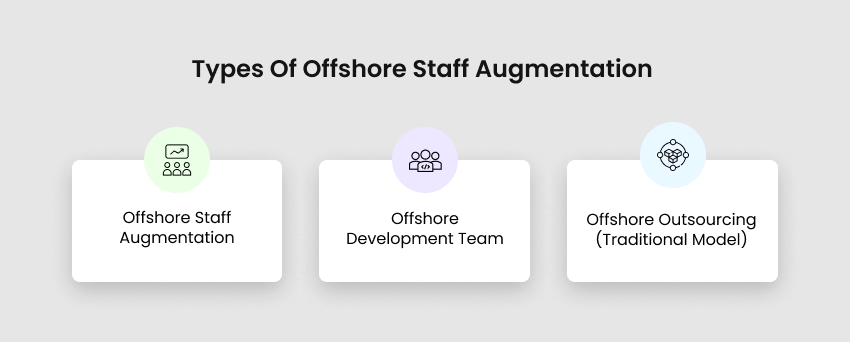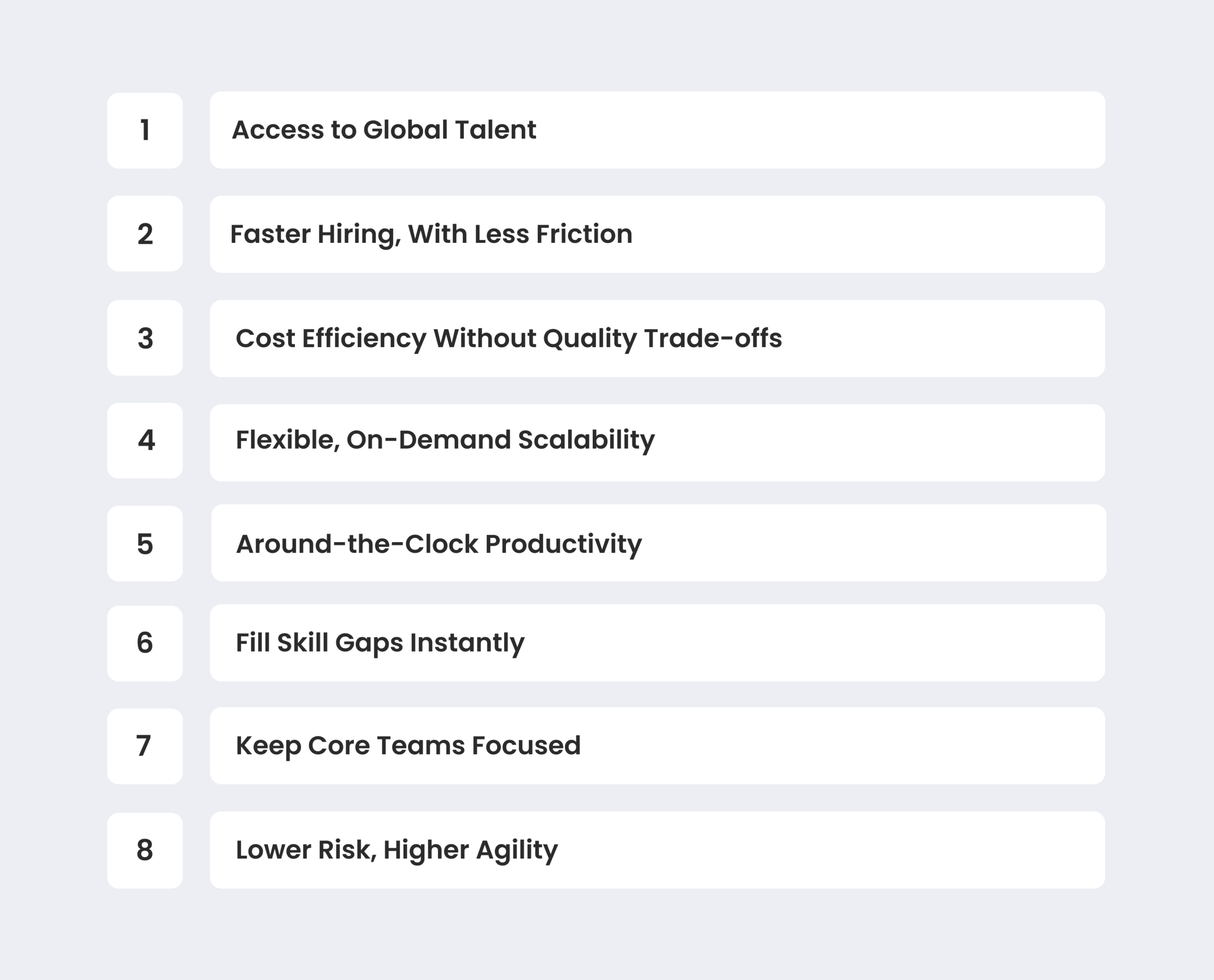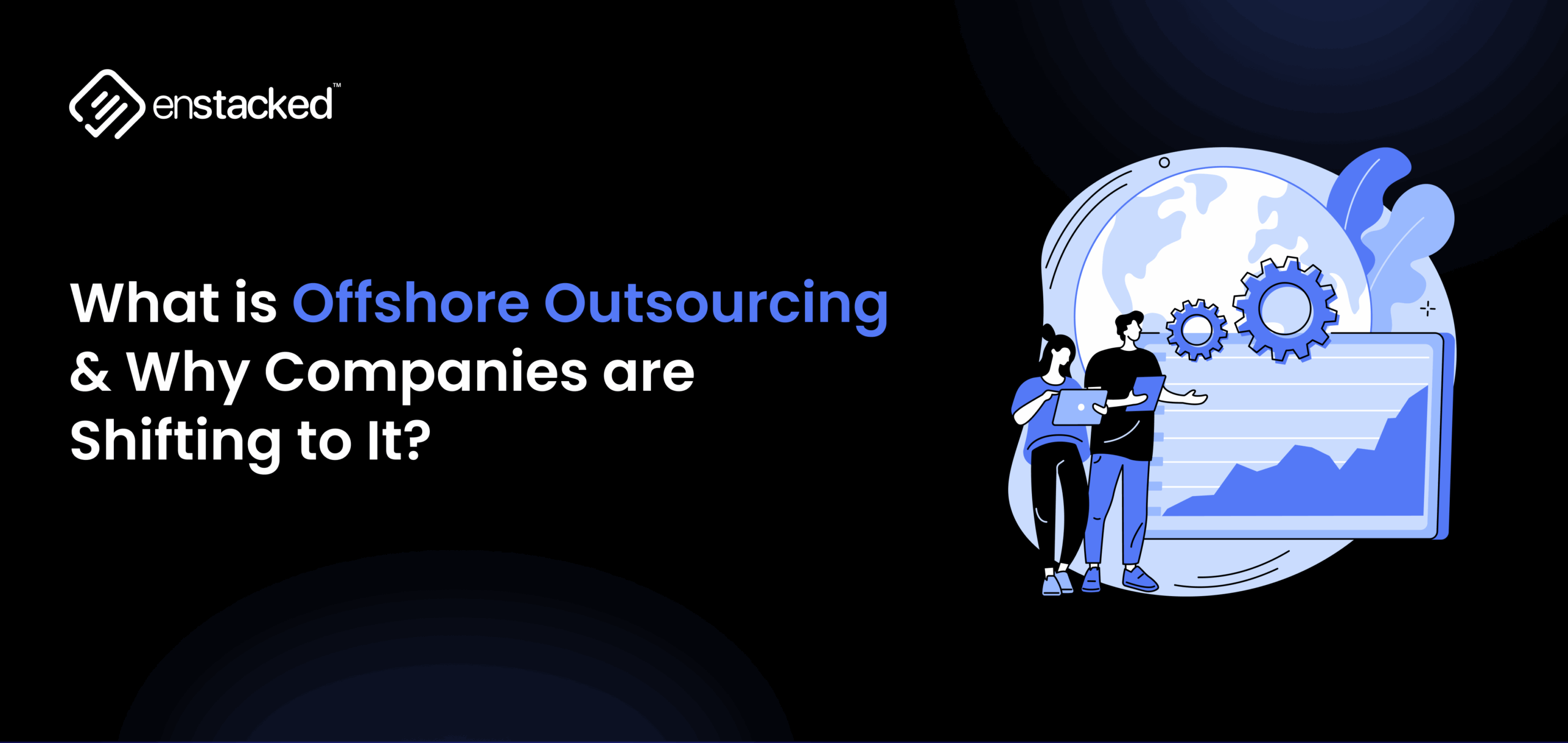Introduction
If you’re reading this, chances are your team is behind schedule, you’re stuck waiting on new hires, juggling too much with a small team, or turning down projects you could’ve taken on… if only the right talent were in place.
You’ve tried hiring locally. You’ve posted on LinkedIn. Your HR is “working on it.” Yet your roadmap keeps slipping.
But, what if scaling your dev team didn’t require 3-month notice periods, recruiter fees, and five rounds of interviews?
This is where offshore staff augmentation comes in. It’s about building global extensions of your in-house team to meet deadlines, fill skills gaps, and give your core engineers breathing room to focus on strategic work.
And no, you are not getting sub-standard work on just cheap rates.
We’re talking about highly skilled and vetted developers, QA engineers, DevOps experts, and designers who can deliver the results your business deserves.
Let’s Numbers do the talk:
- Offshoring can cut costs by up to 40% compared to traditional outsourcing (Source)
- India leads IT offshoring with 90% of top firms on board (Source)
- Offshoring allows 24/7 development cycles when teams are properly coordinated
In this blog, we’ll break down what offshore outsourcing is, the benefits of offshore staff augmentation, when it makes sense (and when it doesn’t), and how you can use it as a lever to outpace competitors who are still stuck hiring the old-school way.
What Is Offshore Staff Augmentation?
Offshore staff augmentation is a hiring model that allows companies to extend their in-house team with remote professionals located in any part of the world.

Unlike traditional outsourcing, where you hand over entire projects to an external vendor, an offshore development team keeps you in control. The offshore professionals work as an extension of your team, follow your tools and processes, attend your stand-ups, and report directly to your internal leads.
Think of it like plugging in on-demand global talent into your existing team, without the cost, delay, or administrative overhead of local hiring.
Also, discover the key differences between Staff Augmentation vs Managed Staffing models.
Types of Offshore Staff Augmentation
When companies decide to go global with their hiring strategy, they often get overwhelmed with terms like offshore staff augmentation, offshore development teams, and offshore outsourcing. While they may sound similar, the structure, control, and use cases differ.
Let’s break down the most common types—and when to use them.

1. Offshore Staff Augmentation
Offshore staff augmentation is a model where you hire remote professionals (developers, QA engineers, designers, etc.) from another country and integrate them into your existing team. These offshore resources report to your managers, follow your tools and processes, and work like full-time team members—just remote.
Best for:
- Startups or product teams needing to scale quickly
- Companies that want full control over development
- Long-term projects where culture fit and integration matter
2. Offshore Development Team
Offshore staff augmentation is a model where you hire remote professionals (developers, QA engineers, designers, etc.) from another country and integrate them into your existing team. These offshore resources report to your managers, follow your tools and processes, and work like full-time team members—just remote.
Best for:
- Companies building a new product or platform from scratch
- Startups that want to set up a full development arm offshore
- Businesses that prefer keeping product development isolated from the in-house team
3. Offshore Outsourcing (Traditional Model)
Now let’s talk about offshore outsourcing in the classic sense. Here, you hand over an entire project or process to a third-party vendor located in another country. This could be software development, customer support, data entry, or even marketing operations.
You don’t manage the individuals—they manage themselves. You just set goals, approve deliverables, and monitor outcomes.
Best for:
- Non-core tasks like support, maintenance, BPO, etc.
- One-off projects with clear requirements
- Companies looking to reduce fixed costs and shift to a vendor-based model
Also, Read the Explained Offshoring vs Outsourcing Difference with Example
The Real Benefits of Offshore Outsourcing (And Why Smart Teams Are Adopting It)
Hiring in 2025 is shifting. Companies now don’t want to wait forever to hire the right talent. Whether you’re a startup trying to ship your MVP or an enterprise balancing multiple product lines, the pressure to move fast without compromising quality is real.
Offshore staff augmentation offers a solution that helps you hire on the go, scale up & down as needed, and get the results you deserve.
Let’s dig in more!

1. Access to Global Talent
The best person for the job might not live in your city or even your country. But, with staff augmentation and offshore outsourcing, you have access to global talent. You’re no longer limited by local talent shortages or inflated salary markets.
Instead, you tap into deep global talent pools from India, Eastern Europe, and Latin America, where highly skilled developers, designers, and QA engineers are available and have the know-how of working with international teams and agile processes.
2. Faster Hiring, With Less Friction
Hiring a senior developer locally can take 6–8 weeks or more from sourcing to offer acceptance to onboarding. That’s a lot of downtime, and most companies are not willing to wait this long.
An offshore development team helps with faster hiring as they have bench-ready candidates who can join within days. These professionals are often pre-screened, technically vetted, and ready to integrate into your workflows.
3. Cost Efficiency Without Quality Trade-offs
Outsourcing isn’t about “cheap labor.” It’s about cost-effective access to high-quality talent.
Hiring a mid-to-senior developer in the US or UK could cost anywhere from $90K to $150K/year, plus benefits, overhead, and recruitment costs.
In contrast, an offshore development team with equal experience and technical depth can be brought on at 40%–70% lower costs, depending on the region.
So, why hire expensive when you can hire smart?
4. Flexible, On-Demand Scalability
- Need 3 React devs for a product sprint? Done.
- Want to pause the QA team after launch? No problem.
Staff augmentation offshore outsourcing gives you on-demand flexibility, without long-term commitments, layoffs, or legal complications. This flexibility is especially useful for project-based companies, agencies, or product teams with unpredictable development cycles.
Why it matters: You align your engineering resources with business needs, exactly when you need them.
“Offshoring is about finding professionals who bring dedication and adaptability to every project. When you find these individuals, location becomes irrelevant.” – Burkhard Berger — Founder & CEO
5. Around-the-Clock Productivity
With team members across time zones, you unlock round-the-clock development cycles. While your core team sleeps, your offshore development team will continue with the progress. You wake up to code pushes, resolved tickets, and progress reports.
Also, you can be able to deliver the results in different time zones.
With an offshore development team, you can turn your 8-hour day into a 16-hour sprint without burning out your local team.
6. Fill Skill Gaps Instantly
You might have a great in-house team, but there will always be gaps. Staff augmentation offshore outsourcing lets you quickly bring in specialists.
- whether it’s a React Native dev,
- a Salesforce consultant,
- a machine learning engineer,
- or someone with legacy system experience.
No need to retrain your team or compromise on timelines. You just add the missing piece.
Why it matters: You deliver more complete, more competitive products without overloading your internal team.
7. Keep Core Teams Focused
Your full-time employees should be focusing on product innovation, architecture decisions, and mission-critical priorities. With staff augmentation offshore outsourcing, the dedicated developers can take care of routine development, maintenance, QA, and technical debt cleanup—freeing your best people to do their best work.
As per Deloitte, Enabling focus on core functions” is the most common perceived benefit among companies that use outsourcing
8. Lower Risk, Higher Agility
Offshore staff augmentation doesn’t require long-term contracts or permanent commitments. That means lower risk when projects change, priorities shift, or funding rounds fluctuate.
Why it matters: You stay agile. You don’t carry people you don’t need. And you’re always ready to pivot.
Final Thoughts!
Offshore staff augmentation gives strategic advantage. In a world where timelines are shrinking and competition is relentless, the ability to scale your team on demand, without compromising quality or control, is what separates fast-moving companies from those stuck in hiring bottlenecks.
That’s where Enstacked comes in.
We’re not a freelance marketplace. We’re a curated team of highly skilled, pre-vetted developers, designers, and marketers, ready to plug into your workflows. Whether you need a single React developer or an entire cross-functional squad, we’ve helped startups and enterprises alike scale without the delays, overhead, or guesswork.
So if you’re ready to expand your team and want to hire dedicated developers from India, Enstacked has you covered. Book your free consultation today to get things started.
Frequently Asked Questions(FAQs)
What is an example of offshore outsourcing?
Example: A U.S.-based SaaS company hires dedicated developers from India to build and maintain its mobile app. This is offshore outsourcing because the work is done by an external vendor located in another country.
What is a disadvantage of offshore outsourcing?
One major disadvantage of offshore outsourcing is the potential for communication or time zone challenges, especially if not managed properly. It can also be harder to align on expectations if the vendor lacks transparency.
Why are many companies in the United States using offshore outsourcing?
Many U.S. companies use offshore outsourcing to reduce hiring costs, access hard-to-find tech skills, and speed up project delivery without expanding their internal headcount or infrastructure.
